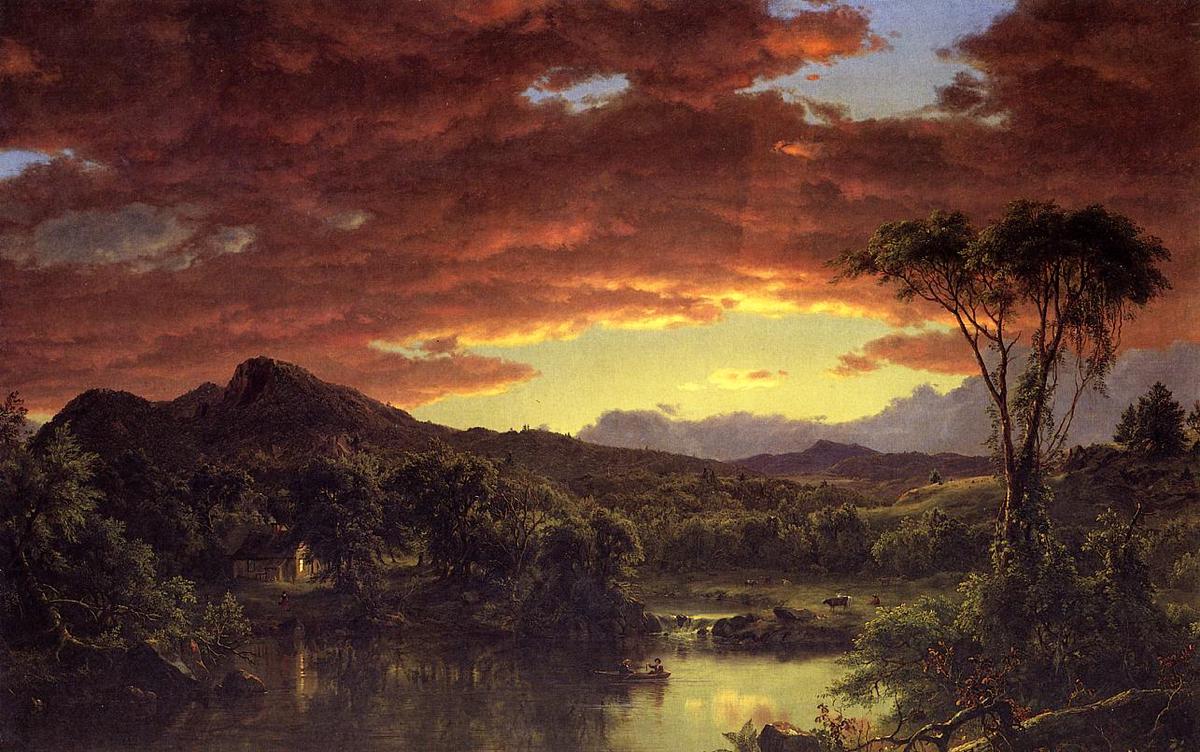Artistic Dimensions and Specifications
Frederic Edwin Church's "Heart of the Andes" is a masterpiece of grand scale, measuring:
- Height: 167.9 centimeters (66.1 inches)
- Width: 302.9 centimeters (119.3 inches)
This substantial size complements its extensive details, inviting viewers to immerse themselves in the Andean landscape.
Crafted in 1859, this oil on canvas painting exemplifies Romanticism, showcasing Church's keen perception of nature derived from his South American adventures. The painting transitions from serene water pools to rugged peaks, demonstrating Church's mastery in varying textures and scales.
The vivid depiction nods to the visual storytelling popular in Church's era, with each brushstroke conveying tales from his travels. The oil medium lends authenticity and depth to the piece, blending detail and broad strokes to create a commanding presence reminiscent of the Andes themselves.
Artistic Influences and Stylization
Church's "Heart of the Andes" reflects the aesthetic principles of theorists like William Gilpin and John Ruskin:
- Gilpin's picturesque principles: Value the balance between smooth and rough textures, evident in the painting's harmonious depiction of gentle hills and robust mountains.
- Ruskin's influence: Visible in Church's meticulous attention to detail, where every leaf, bird, and branch contributes to an intricate composition.
This approach transforms the landscape from mere representation to a celebration of nature's complexity.
Church's work bridges art and philosophy, offering an experience that goes beyond the visual. His stylization invites viewers to imagine themselves within the Andean landscape, creating a connection between the audience and the distant, majestic scene.

Historical Exhibition and Reception
The 1859 unveiling of "Heart of the Andes" at New York's Tenth Street Studio Building was a significant event. The painting was dramatically presented under gas lighting, creating an ethereal atmosphere. For twenty-five cents, over 12,000 art enthusiasts viewed the work, making it a cultural phenomenon.
The initial reception was enthusiastic, with audiences deeply moved by the painting's grandeur. Its impact was so profound that some viewers reportedly felt faint, caught between awe and admiration. The painting's success solidified Church's reputation as a premier landscape artist of his time.
"Women felt faint. Both men and women succumb[ed] to the dizzying combination of terror and vertigo that they recognize[d] as the sublime."
"Heart of the Andes" also captivated London audiences during its exhibition from July to mid-August of the same year. The painting's tour across America and its reception in Britain demonstrated its wide appeal and significance in the art world of the time.
In an era of exploration and romantic ideals, "Heart of the Andes" offered viewers a virtual voyage into an awe-inspiring realm. Its unveiling remains a notable moment in art history, showcasing the power of landscape painting to captivate and inspire audiences.
Frederic Edwin Church's "Heart of the Andes" continues to engage viewers with its detailed portrayal of nature's grandeur, inviting us to explore the beauty of the Andean landscape through his artistic vision. This masterpiece, now housed in the Metropolitan Museum of Art in New York, stands as a testament to Church's enduring legacy in American art.
- Metropolitan Museum of Art. Heart of the Andes. The Collection Online. New York, NY: Metropolitan Museum of Art.
- Avery LE. Church's Great Picture, The Heart of the Andes. New York: Metropolitan Museum of Art; 1993.
- Kelly F, Gould SC. Frederic Edwin Church. Washington, D.C.: Smithsonian Institution Press; 1989.





















